Table of Contents
The Water Diaries STORY 1:
BIGASS COMPANY IS IN COMPLIANCE, BUT THE FISH ARE DEAD
Background
BAM (BigAss Mine) completed construction in the early 00’s and started mining and processing. BAM is located somewhere south or east of the border. Maybe South America, maybe Siberia, definitely not Australia, good blokes there, eh.
The BigAss Mine tailings facility was designed as a non-discharge facility. But timing of construction, the wet season, possibly (probably) bad data, higher precipitation than baseline, possibly errors in the water management (possibly failure to build clean water diversions) dictated discharge or other less than favorable scenarios. Overtopping of tailings dams is not a good scenario even south of the border.
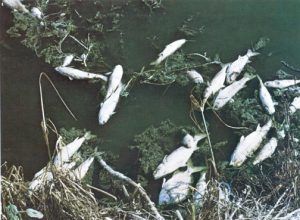
BAM, as most bigass mines do, borrowed money for construction of the mine. Banks as part of their fiduciary responsibility hired outside experts to inspect and audit BAM. There were lots of experts and as the natural character of experts, particularly mine engineer experts, they have their expert opinions on how mines should be constructed and operated. Sometimes, right or wrong, those opinions differ from the mine management, mine management contractors and consultants. Such was the case with BAM, internal experts and external experts with lots of ideas and opinions. Meetings were often and translators made lots of dinero. Russian is not easy. That’s pretty much a fact. I digress but this is important background as you may or may not agree.
BAM, as most bigass mine do (particularly in times of shit hitting the fan, be it the money fan, the safety fan, or in this case the environmental fan), decided with the transition from construction to operations, it was time for change, new management. The new and lucky environmental manager came onto the scene.
As most expert and excellent environmental managers do when hired, he/she establishes positive relationships with the operation managers. Sports and alcohol are useful tools. Individual and team meetings are set up with mining and processing teams for formal exchange of issues (maybe dead fish downstream of the discharge point), data, regulatory compliance, corrective action plans and schedule for implementation. Being the most excellent environmental manager, he/she would never dictate corrective actions to the mine or processing team, particularly the processing team. Those guys know their water chemistry pretty well and just need to know the regulatory parameters or in this case (see title, wtf is killing the fish) to make the corrective actions in the processing and water management and treatment scheme.
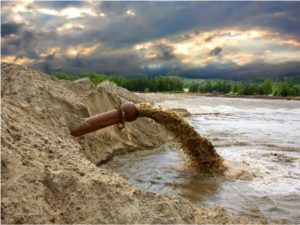
Also, being the most excellent environmental manager (let’s go with a new acronym MEEM), the MEEM does routine drives around with the environmental staff, as well as, mining and processing personnel on a regular, in this case, daily basis.
During the initial tour of the tailings discharge point and the regulatory end of pipe discharge point, the MEEM noted to Process Manager, this smells like being inside the concentrator and some of those fantastic reagents that liberate or depress the desired, or not so desired metal of choice. The MEEM also noted the foam further downstream. This was not the MEEM’s first processing rodeo, but promoting excellent team building and relationship skills, the MEEM posed the observation as a question, so as not to come across in an offensive or condescending manner. Nobody likes an environmental dick head. Again, digression but I get paid by the word (I hope) and more important, we all know enviro/social/community D heads, male and female I guess. We never use the B word (one can get fired even south of the border).
Back to the background, a non-discharge tailings management facility that is discharging. And, odor and foam at the discharge point into the receiving water stream that happened to have trout, non-native. Did I mention that the enviro team advised that we had floating trout that made it downstream to the local community, couple of miles or kilometers (readers choice of measurement tool)? During the drive around with the Social/Community Manager, the MEEM was advised that the local community leaders were not very happy with the odor, foam and dead fish. During the drive around with the Processing Manager and follow-up meetings, the MEEM was advised that the end of pipe discharge point and the downstream receiving water point were in compliance with country water quality regulations and World Bank water quality (guideline) parameters. World Bank and International Finance Corporation guidelines and performance standards were part of the Banks lending requirements package. The Banks’ experts were also not pleased with dead fish conundrum, as noted in their monthly reports.
The MEEM had a quandary, in compliance but dead fish.
Facts
BAM Tailings Pond Chemistry
The BAM tailings pond water chemistry is dependent on three factors:
- The geochemistry of the tailings slurry;
- The residual reagents from the mill, still present in the tailings slurry; and,
- Dilution and geochemical reactions, including the effects of wind and sun, on tailings water over time.
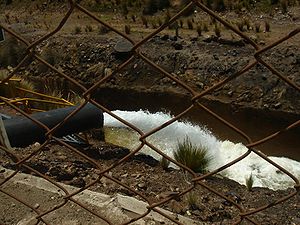
The BAM tailings water chemistry changed rapidly in response to the chemistry of the tailings, primarily with respect to pH and dissolved copper/cyanide. The sodium cyanide used during the concentrator processing complexes with the dissolved metals and was found in the tailings water primarily as a dissolved copper-cyanide complex. The concentration of dissolved copper was proportional to the concentration of dissolved cyanide in the tailings slurry and pond water. This ratio changed over time as “less-oxidized” ores are processed.
Water treatment for cyanide destruction was implemented in the mill and during emergency discharge periods in the tailings pond to ensure compliance with respect to cyanide and dissolved copper concentrations. Lime addition was also used to enhance precipitation of copper from the tailings pond water. Aeration of the tailings pond water was used to enhance volatilization and oxidation of residual reagents, degradation of cyanide and to decrease alkaline pH. The process team implemented best practice in the concentrator to reduce reagent usage (sodium cyanide, frother, xanthates, etc) and improve the control of pond water chemistry.
The following is a brief discussion of the reagents used in the concentrator for different ore types.
BAM Flowsheet Description
The BAM concentrator used grinding and flotation processes. The flotation circuit was a conventional copper/zinc circuit producing primarily a bulk copper concentrate and a zinc concentrate. The bulk copper concentrate was further processed in subsequent flotation stages to recover molybdenum.
Reagents
The BAM milling reagents that are of particular interest with respect to water quality were:
- Lime, with respect to pH control;
- Sodium cyanide, with respect to concentrations of cyanide and metallo-cyanide complexes in tailings water;
- Frother, with respect to foam downstream;
- Frothers and xanthates, with respect to odor; and,
- Hydrogen peroxide for cyanide destruction
- Sodium hydrosulphide, recently introduced for molybdenum flotation.
The quantity of reagent used depends on the type of ore being milled, typically:
- Lime use depended on the presence of copper and degree of oxidation – typically copper was floated with a small addition of lime (pH 8.5 to 9.0).
- Sodium cyanide was used for several reasons in the concentrator:
o primarily, to complex aqueous metals and prevent activation of minerals (e.g. prevent zinc from reporting to the copper concentrate), and thus more cyanide is required when processing oxidized ores;
o to depress sulphides, such as pyrite, and increase the grade of the concentrate.
Ecotoxicology
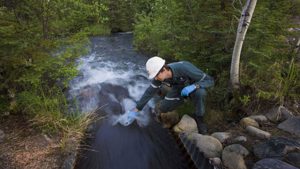
Environmental toxicology is a multidisciplinary field of science concerned with the study of the harmful effects of various chemical, biological and physical agents on living organisms. Ecotoxicology is a subdiscipline of environmental toxicology concerned with studying the harmful effects of toxicants at the population and ecosystem levels. (Wikipedia)
BAM had not completed aquatic toxicity testing to determine what effects discharge effluents would have on water quality, fish, and aquatic resources in the receiving streams impacted by the mine activities including pits, overburden storage area, waste disposal area, low-grade stockpiles and tailings.
Action Plan
The BAM management team including primarily the environmental and processing departments prepared a Request for Proposal including,
Study Objectives
- conduct an ecotoxicological assessment of tailings impoundment effluent as it interacts with the downstream environment; and
- assess current effluent and receiving water limits and parameters, and provide a sound basis for establishment, or re-establishment of site-specific criteria.
Task and Deliverables
TASK: Ecotoxicological Effects of Tailings Impoundment Discharge to
Receiving Water Aquatic Resources
Assess the ecotoxicological effects of tailings water discharge to aquatic resources of the watersheds affected by BAM mining operations. Consider the effects of water quality from different ore campaigns. This task is the first priority in this project and should be based on short term acute and chronic toxicity testing, historical monitoring information, information from other relevant studies conducted elsewhere, and other information considered relevant by the Consultant.
Deliverable:
Report detailing testing procedures, results, conclusions with respect to potentially adverse effects.
Mitigation Measures
If potentially adverse impacts or effects are identified, assist in development and provision of mitigation measures.
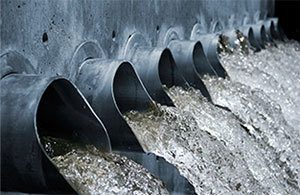
Deliverable:
Report outlining adverse effects, mitigation options, pros/cons, practicality, effectiveness, approximate cost of each option, and recommended option.
TASK: Ecotoxicological Effects of Tailings Impoundment Discharge to
Downstream Environment
Including water quality, sediment, fish, invertebrates, algae, and mammals. Consider the effects of water quality from different ore campaigns. It is recognized that some components of this task may use testing results of Task 1, which is a higher priority task. It is also recognized that fully comprehensive conclusions from this assessment may only be achievable through long term study. Due to information being required in the near future, conclusions of this assessment should specify the limitations and assumptions used and be based on shorter term acute and chronic toxicity testing, historical monitoring information, information from other relevant studies conducted elsewhere, and other information considered relevant by the Consultant.
Deliverable:
Report detailing testing procedures, results, limitations of study, assumptions, conclusions with respect to potentially adverse effects, recommendations for longer term data acquisition.
Mitigation Measures
If potentially adverse impacts or effects are identified, assist in development and provision of mitigation measures.
Deliverable:
Report outlining adverse effects, mitigation options, pros/cons, practicality, effectiveness, approximate cost of each option, and recommended option.
Water Quality Limits and Parameters Assessment
Evaluate and assess the current receiving and effluent water quality compliance limits, standards and guidelines applicable to this project. Provide a basis and rationale for justifying or refuting established parameters and limits, particularly copper, molybdenum, total suspended solids, nitrate, and CN species. Conclusions to be based on results of previous Tasks, standards elsewhere in the world, information from other relevant studies conducted elsewhere, and other information considered relevant by the Consultant.
Deliverable:
Report systematically assessing various regulatory requirements, standards and guidelines, recommending changes, and providing sound justification for such changes.
Portions of the request for proposal and scope of work have been revised, redacted and deleted to protect the innocent.
DISCLAIMER: To protect the writer all names, locations, and persons may or may not be real. Wherever the reader may the mine, personnel, country may be; the mine, people and country are not. It probably was just a bad dream.
To be continued….
Water Diaries
Story 2, The Proposal, The Study, Why The Fish Died (Probably), Lessons Learned
